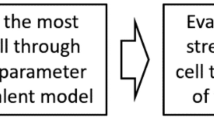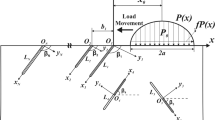Abstract
A numerical lattice-based approach equipped with a brittle erosion algorithm and material forces in the context of LEFM and configurational mechanics is introduced to analyze contact fatigue life and crack propagation of brittle solids under low amplitude cyclic loading using the classical Paris’s law. Material force vectors at lattice nodes were employed in identifying potential crack path in high-cycle fatigue applications. A 2D plane strain pad-substrate system with contact formulations under constant compression and cyclic sinusoidal shear with constant amplitude was considered to investigate fatigue crack’s growth rate and its shape in the substrate, made of hydrided brittle Zircaloy-4 used in nuclear industry. The capability of the lattice in predicting the crack extension path using the material force vectors at the crack tip is verified by comparing with analytical solutions for a centered crack domain under pure shear and direct tension loading, and also for an initial small surface crack for the contact fatigue pad-substrate system. Obtaining the total fatigue life by assuming a failure value for the crack length and confirming the Paris’ law crack growth, the lattice results demonstrate that the fatigue crack path in the substrate is a curved trajectory which gradually reduces as the fatigue crack tip grows deeper into the substrate. Having simple constitutive formulation and straightforward erosion algorithm, this approach together with configurational mechanics implications can be employed in analyzing fretting fatigue problems.










Similar content being viewed by others
References
Eshelby JD (1951) The force on an elastic singularity. Philos Trans R Soc Lond A Math Phys Eng Sci 244(877):87–112
Mohammadipour A (2015) Interface fracture in masonry composites: a lattice approach. Ph.D. thesis, University of Houston
Paris PC, Gomez MP, Anderson WE (1961) A rational analytic theory of fatigue. Trend Eng 13(1):9–14
Gurtin ME (2000) Configurational forces as basic concepts of continuum physics, vol 137. Springer, Berlin
Ballarini R, Royer-Carfagni G (2016) A newtonian interpretation of configurational forces on dislocations and cracks. J Mech Phys Solids 95:602–620
Mohammadipour A, Willam K (2017) On the application of a lattice method to configurational and fracture mechanics. Int J Solids Struct 106—-107(C):152–163
Mohammadipour A, Willam K (2017) On energy release rates and configurational forces for interfacial propagating cracks: a lattice approach with a brittle erosion technique. J Appl Mech 84(2):021,011
Suresh S (1998) Fatigue of materials. Cambridge University Press, Cambridge
Giannakopoulos A, Lindley T, Suresh S (1998) Aspects of equivalence between contact mechanics and fracture mechanics: theoretical connections and a life-prediction methodology for fretting-fatigue. Acta Mater 46(9):2955–2968
Tanaka K, Mutoh Y, Sakoda S, Leadbeater G (1985) Fretting fatigue in 0.55 c spring steel and 0.45 c carbon steel. Fatigue Fract Eng Mater Struct 8(2):129–142
Antoniou R, Radtke T (1997) Mechanisms of fretting-fatigue of titanium alloys. Mater Sci Eng A 237(2):229–240
MATLAB (2014) version 8.3.0.532 (R2014a). The MathWorks Inc., Natick, Massachusetts
Mohammadipour A, Willam K (2016) Lattice simulations for evaluating interface fracture of masonry composites. Theor Appl Fract Mech 82:152–168
Mohammadipour A, Willam K (2016) Lattice approach in continuum and fracture mechanics. J Appl Mech 83(7):071,003
Mohammadipour A, Willam K (2017) Effect of thermomechanical loading on fracture properties of brittle materials: a fully-coupled transient thermoelastic analysis using a lattice approach. Int J Solids Struct 129(C):156–166
Mohammadipour A, Alemi A (2017) Micromechanical analysis of brain’s diffuse axonal injury. J Biomech 65:61–74
Bolander JE, Saito S (1998) Fracture analyses using spring networks with random geometry. Eng Fract Mech 61(5):569–591
Biot MA (1956) Thermoelasticity and irreversible thermodynamics. J Appl Phys 27(3):240–253
Gurtin ME, Fried E, Anand L (2010) The mechanics and thermodynamics of continua. Cambridge University Press, Cambridge
Hughes TJ (1987) The finite element method: linear static and dynamic finite element analysis. Courier Corporation, North Chelmsford
Wriggers P (2006) Computational contact mechanics. Springer, Berlin
Eshelby J (1975) The elastic energy–momentum tensor. J Elast 5(3–4):321–335
Maugin GA (1993) Material inhomogeneities in elasticity, vol 3. CRC Press, Boca Raton
Mueller R, Maugin G (2002) On material forces and finite element discretizations. Comput Mech 29(1):52–60
Mueller R, Gross D, Maugin G (2004) Use of material forces in adaptive finite element methods. Comput Mech 33(6):421–434
Steinmann P, Scherer M, Denzer R (2009) Secret and joy of configurational mechanics: from foundations in continuum mechanics to applications in computational mechanics. ZAMM J Appl Math Mech 89(8):614–630
Rice JR (1968) A path independent integral and the approximate analysis of strain concentration by notches and cracks. J Appl Mech 35(2):379–386
Williams M (1957) On the stress distribution at the base of a stationary crack. J Appl Mech 24:109–114
Erdogan F, Sih G (1963) On the crack extension in plates under plane loading and transverse shear. J Basic Eng 85(4):519–525
Wisner SB, Reynolds MB, Adamson RB (1994) Fatigue behavior of irradiated and unirradiated zircaloy and zirconium. In: Zirconium in the nuclear industry: tenth international symposium. ASTM International
Acknowledgements
This research was supported by the US Department of Energy, Nuclear Energy University Program (NEUP), under the Integrated Research Project No. DE-FOA-0001281 named “Cask Mis-loads Evaluation Techniques, IRP-FC-2”.
Author information
Authors and Affiliations
Corresponding author
Ethics declarations
Conflict of Interest
The authors declare that they have no conflict of interest.
Additional information
Publisher's Note
Springer Nature remains neutral with regard to jurisdictional claims in published maps and institutional affiliations.
Rights and permissions
About this article
Cite this article
Mohammadipour, A., Willam, K. Application of configurational mechanics in characterizing contact fatigue life and its crack propagation: a numerical lattice-based approach. Comput Mech 63, 1301–1313 (2019). https://doi.org/10.1007/s00466-018-1650-1
Received:
Accepted:
Published:
Issue Date:
DOI: https://doi.org/10.1007/s00466-018-1650-1




